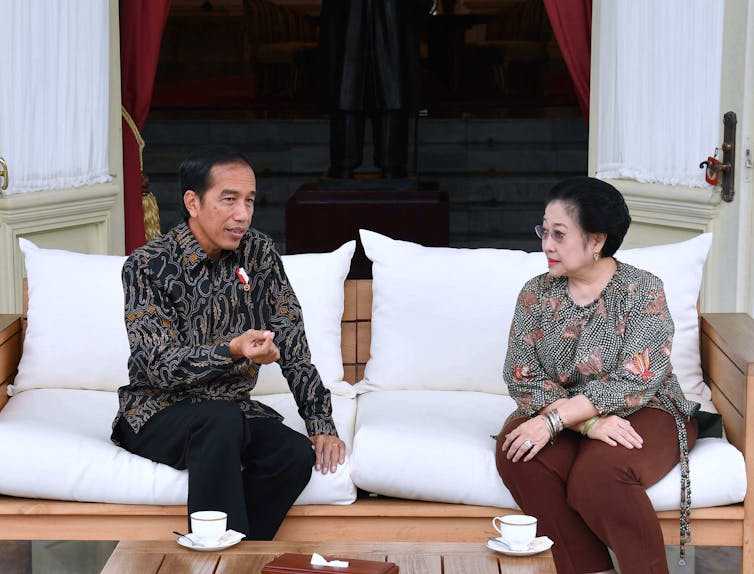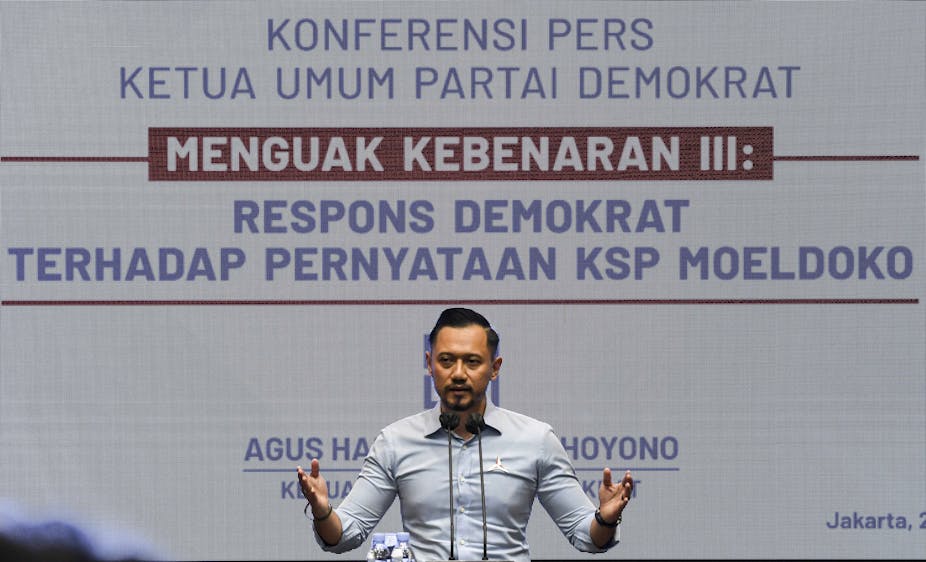In early March this year, a retired Indonesian army general named Moeldoko was elected chairman of the Democratic Party (known locally as Partai Demokrat or PD) in a controversial extraordinary congress. Moeldoko — who, like many Indonesians, goes by just one name — is also the chief of staff of Indonesian President Joko “Jokowi” Widodo.
Moeldoko ousted Agus Harimurti Yudhoyono, the son of Jokowi’s predecessor, former president Susilo Bambang Yudhoyono (commonly referred to by his initials SBY). SBY led the Democratic Party throughout his presidency from 2004 to 2014.
In early April, the government refused to recognise Moeldoko as chairman of PD on the grounds certain administrative requirements hadn’t been met by a government-set deadline. This ruling means Agus Harimurti Yudhoyono still holds chairmanship of PD.
The PD split, although it didn’t last long, was not the first party political schism in Indonesia’s political history. The United Development Party (PPP) and the Golkar Party have also split in the past.
I studied how Indonesian parties and its party system have changed since the fall of ex-president Soeharto (a dictator who ruled Indonesia from 1966 until his resignation in 1998) and the subsequent shift to democratic, direct presidential elections.
Presidentialism in Indonesia creates very specific political dynamics. It has fostered factionalism, where infighting is driven not by different policy ideas, but by the struggle for money, jobs, and power.
Effects of presidentialism
In general, presidentialism is marked by the executive branch’s dual origin and distinct survival strategies: the president and parliament are both directly elected, and the president can only be removed through impeachment.
Under his New Order regime, president Soeharto amassed enormous and almost unchecked power; the People’s Consultative Assembly (Majelis Permusyawaratan Rakyat, MPR) was the highest state organ on paper only.
Soeharto controlled Golkar — the regime party — and was able to subdue the Democratic Party of Indonesia (Partai Demokrasi Indonesia or PDI) and the PPP, which were then, at best, two semi-oppositional parties.
After his fall in 1998, the lawmaking power of the House of Representatives (Dewan Perwakilan Rakyat or DPR) was strengthened considerably.
Nevertheless, the early reform period — known locally as Reformasi — was marked by uncertainty.
The impeachment of president Abdurrahman “Gus Dur” Wahid in 2001 was the result of a power struggle between the DPR, the MPR, and a president who strongly disagreed with parliament about the authority of his office.
As a reaction to the upheaval created by Gus Dur’s fall, direct presidential elections were held for the first time in the country’s history in 2004.
Presidentialism tends to entail particular forms of factionalism, especially on grounds of a dualism between the president and his/her party. As the president is directly elected, he/she is not as dependent on the support of parliament (and political parties) as a prime minister would be.
Factionalism in presidential systems is, of course, not only a question of electoral rules governing whether parties are well-organised or institutionalised.
Parties can be more factionalised if intra-party democracy is higher, if the political economy of parties does not benefit single financiers, if the party is rather decentralised, if organisational regulations (for example on party membership or the election of the executive board) are not well-defined, and so on.
If new parties, such as in Indonesia, do not have a realistic chance to succeed because of – among other things – a high electoral threshold, regulations demanding the establishment of a high number of branches, and the need to finance very expensive campaigns, the tensions between different groups cannot easily be solved by creating new parties.
In Indonesia, presidentialism has brought at least three effects.
First, it has resulted in the establishment of political parties for the purpose of fostering a presidential candidate (or a candidate for other important positions).
The PD, the People’s Conscience (Hanura) Party, Gerindra, and NasDem Party come to mind.
This is only possible in political systems within which rich people can build such vehicles from scratch.
Presidentialism here means the rise of more or less charismatic leaders with their own vehicles.
Factionalism in these parties is low if the party leader is very strong (like Gerindra party leader and presidential-hopeful, Prabowo Subianto).
But factionalism is strong when the party leader — such as former president and PD leader SBY — allows for some competition or is forced to live with it, for example when he leaves office.
Second, there are outsiders like the current president, Jokowi, who have made their careers substantially without their own parties, or at least without strong roots in one of the big parties.
Then, presidentialism can foster a dualism between the outsider and the party apparatus. This was apparent in the tension between Jokowi and Megawati Soekarnoputri, chief of the Indonesian Democratic Party of Struggle (PDI-P).
Third, over the years Jokowi has become a very powerful president and seems to be able to indirectly intervene in other parties’ internal infighting to manufacture the rise of factions supporting his presidency. Examples are the PPP, Golkar and, maybe, the PD.
The altercations in the PD are, arguably, characterised by a mixture of all these effects of presidentialism.

Remedies
Indonesian political parties collude and build grand coalitions; their platforms are not much different from each other.
The distinction between left and right-wing parties is almost meaningless. Parties have become part of a cartel and have been involved in numerous corruption cases at the national and sub-national levels.
Infighting often takes the form of factionalism marked by clientelism — in other words, the struggle about money, jobs, and power.
In contrast, policy-based factionalism, which is rare or nonexistent in Indonesia, is predominantly about political ideology. Different groups within the party fight over basic political ideas and connected strategies.
Indonesia needs parties with meaningful platforms representing the full spectrum of ideas from the political right to the political left.
To promote this, a strict regime of party and candidate financing combined with a selection of candidates based on binding rules on intra-party democratic procedures could be introduced.
Maybe then the groups within parties would not see their organisations merely as tools of power and patronage. Instead, debate could begin on how to craft complex policies on financial, economic, environmental, and health issues to serve the best interests of Indonesian voters.


